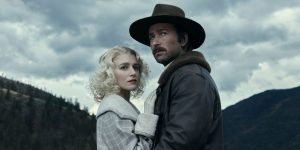Tony Curran, known for his powerful performances in series like Outlander and Doctor Who, has recently sparked passionate debate across the entertainment industry with his bold critique of the Emmy Awards’ treatment of 1923. The actor, who has long admired the creative force behind Taylor Sheridan’s Yellowstone universe, voiced frustration over what he considers a blatant snub of one of television’s most compelling period dramas. According to Curran, 1923 was not only a visual and emotional triumph, but also an important cultural artifact that deserved far more recognition than it received during awards season. His passionate statements, delivered during a recent panel discussion, have resonated deeply with fans, critics, and fellow actors alike—many of whom agree that 1923 was, indeed, a modern television masterpiece that got lost in the overwhelming noise of mainstream awards campaigning.
Starring legendary talents like Harrison Ford and Helen Mirren, 1923 expands on the Yellowstone legacy by delving into the Dutton family’s origin story amid the backdrop of post-World War I America. Set during the turbulent interwar years, the series weaves together historical events such as the Great Depression, Prohibition, and Indigenous struggles against assimilation—offering a textured, poignant, and sometimes brutal look at early 20th-century America. What made 1923 stand out wasn’t just its star power or high production value—it was the complexity of its characters and the moral ambiguity of their choices. From ranching conflicts to colonial oppression and war trauma, the show unflinchingly tackled difficult themes that are often overlooked in modern Westerns.
Curran, who knows the difficulty of creating emotionally rich period dramas, argued that 1923 represented the kind of television that challenges viewers to think deeply about identity, legacy, and survival. “This wasn’t just another dusty Western,” Curran said. “It was a story about people confronting the worst parts of themselves, their past, and their future. It was cinematic, poetic, and relentlessly honest.” He went on to express confusion over how such a daring, beautifully acted series could be ignored by an institution that claims to honor excellence in television. His comments immediately drew praise from fans of the show, who had already been sharing their disappointment across social media after Emmy nominations were announced without a single major nod for 1923.
Many fans and critics point out that the performances in 1923 were not only awards-worthy but transformative. Harrison Ford, in particular, delivered one of his most introspective and vulnerable roles in decades, portraying Jacob Dutton as a man burdened by responsibility, loyalty, and loss. Helen Mirren was equally mesmerizing as Cara Dutton—a woman of quiet strength, sharp intelligence, and deep emotional reserves. Their chemistry brought an authenticity to the series that elevated it beyond typical genre fare. Supporting performances from Brandon Sklenar, Julia Schlaepfer, and Aminah Nieves also drew critical praise, especially Nieves, whose portrayal of Teonna Rainwater—a young Native American girl navigating the horrors of residential schooling—was heartbreaking and unforgettable.
Critics who agree with Curran argue that the Emmy snub speaks to a broader problem within awards institutions: a tendency to prioritize buzz, big-budget streaming series, or social media hype over quieter, more nuanced storytelling. Shows like 1923, which explore painful historical truths and use slow-burn narratives, often struggle to compete in a media landscape dominated by spectacle and fast-paced drama. Curran’s defense of the series, then, becomes more than just a critique of Emmy voters—it’s a call for the industry to reevaluate what truly constitutes “award-worthy” television.
Interestingly, this is not the first time a Taylor Sheridan project has been overlooked by major award shows. Despite Yellowstone being one of the most-watched series on television, it too has often been snubbed by the Emmys. This pattern has led some to speculate whether Sheridan’s unapologetically American storytelling, with its rural settings and focus on rugged individualism, simply doesn’t fit the tastes of Emmy voters based in urban coastal centers. Others argue that the prestige TV landscape still undervalues Westerns—viewing them as outdated or lacking in cultural relevance, despite the evolution of the genre in series like 1883, Yellowstone, and now 1923.
Tony Curran’s comments, however, have reignited interest in 1923—not just as entertainment, but as art. Viewers who may have initially skipped it are now revisiting the series with fresh eyes, encouraged by the endorsement of a respected actor and the groundswell of support across fan communities. For some, the Emmy snub only adds to 1923‘s mystique—solidifying its reputation as an underrated gem in the crowded TV landscape. Others hope that with renewed attention, future seasons (or spin-offs) of the Sheridan universe will finally receive the institutional recognition they deserve.
Curran’s statements also raise larger questions about the evolving role of awards shows in the streaming era. With hundreds of new series launching each year, is it still realistic to expect a small voting body to capture the full scope of television excellence? Or do awards like the Emmys risk becoming echo chambers that reward the same safe choices while overlooking truly daring work? As viewers gain more power through social media and streaming data, some argue that the “audience voice” is becoming just as influential as critical consensus—perhaps even more so. Curran’s outcry may be part of a larger shift, where fans and artists are no longer willing to accept traditional snubs without protest.
In the end, whether 1923 wins statues or not may matter less than the legacy it leaves behind. For Tony Curran and thousands of fans, the show has already succeeded where it counts most: in storytelling, impact, and artistic integrity. It told stories that mattered, gave voice to underrepresented histories, and delivered unforgettable performances. No gold trophy can replace that. Curran’s voice has simply reminded us that awards are not the final word on greatness—and that sometimes, the best art is the kind that speaks to the soul, whether or not it’s honored on stage.